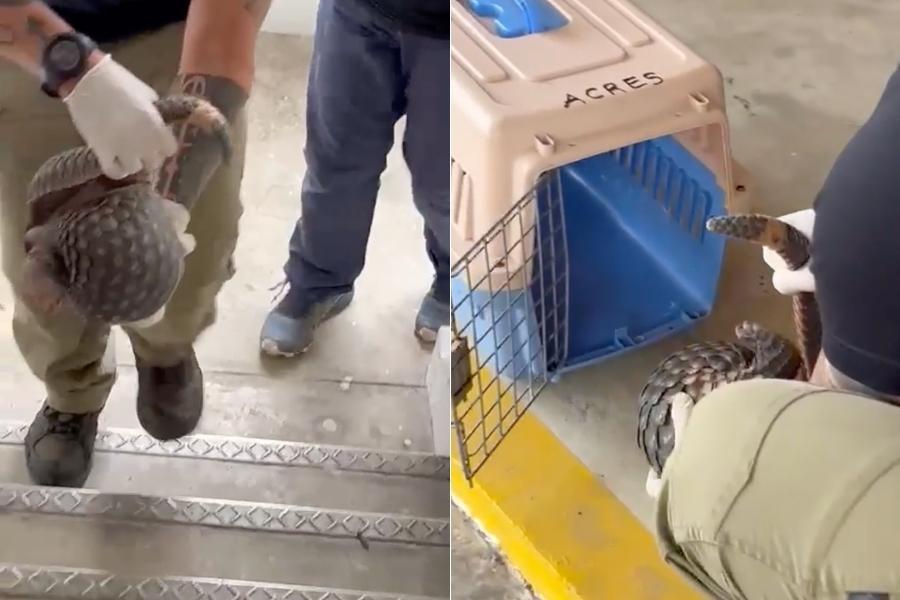Follow us on Telegram for the latest updates: https://t.me/mothershipsg
With around 100 of them left in the wild in Singapore, it is rare to see a Sunda pangolin here.
So imagine a resident's surprise when they saw the little creature in the stairwell of a multi-storey car park at Sembawang.
Resident spotted pangolin and called Acres
Member of Parliament for Sembawang Group Representation Constituency (GRC) Lim Wee Kiak shared the resident's sighting in a Facebook post on Nov. 6.
Lim said the pangolin was spotted in the carpark at Blk 358A Admiralty Drive by a resident in the afternoon on the same day.
Only the bottom half of the little creature's scaly body can be seen in the picture, as it had curled up in a corner and hid itself behind a red water pipe.
 Image from Lim Wee Kiak/Facebook.
Image from Lim Wee Kiak/Facebook.
Lim said the resident called the Animal Concerns Research and Education Society (Acres) to rescue the pangolin.
Acres co-CEO Kalai Vanan told Mothership that they received a call for help at about 4:10pm on Nov. 6.
In a video Lim shared on Facebook, a pair of Acres rescuers, Selwyn and Syazleena, can be seen handling the pangolin gingerly as they made their way up a flight of stairs in the multi-storey car park.
Selwyn and Syazleena exited from the stairwell and walked towards a plastic crate placed on the ground that is presumably for the pangolin. Image screenshot from video on Lim Wee Kiak/Facebook.
Image screenshot from video on Lim Wee Kiak/Facebook.
How did it wind up at the car park?
Kalai told Mothership that the pangolin is a young Sunda pangolin.
While Sunda pangolins have wandered into urbanised residential areas that border on forested areas in Singapore, such instances are rare.
Instead, these creatures are typically sighted at Central Catchment Nature Reserve and Bukit Timah Nature Reserve, in forested areas like Bukit Batok and the Western Catchment Area, and on the islands of Pulau Ubin and Pulau Tekong.
Commenting on the bizarre incident, Lim told Mothership that it was unclear how the Sunda pangolin wound up in the car park's stairwell as the location was not close to nature.
To his knowledge, this was the first time that this has happened.
Kalai, however, was not as surprised by the incident as the pangolin may have came from any of the existing pockets of forest near the car park.
However, he noted that there have been extensive development in the area.
The pangolin, being a juvenile, had likely ventured out of its natural forested habitat, navigating its way through Singapore's drainage network, before it wound up in the car park.
On how the pangolin wound up on a high floor in the car park, Kalai said the scaly creatures are known to be capable climbers.
Hence, the young pangolin could have made its way up the few flights of stairs before it was spotted by the resident and subsequently rescued by Acres.
Will be released into the wild
Kalai said the Sunda pangolin is healthy and will eventually be released back into the wild.
He thanked the public who kept an eye on the little creature while waiting for the Acres team to arrive.
Lim said he is glad that the quick thinking resident called Acres to rescue the pangolin.
He added: "We all need to do what we can to protect and preserve our beautiful biodiversity."
 Image courtesy of Acres.
Image courtesy of Acres.
What to do if you see a Sunda pangolin
If you see a pangolin in Singapore, observe them from a safe distance and do not approach them as these creatures are shy and scare easily.
If the pangolin appears to be wounded or in distress, or is out of its natural forested habitat, call Acres' 24-hour rescue hotline on 9783 7782 or the National Parks Board (NParks) Animal Response Centre on 1800 476 1600.
You should also call NParks at 1800 471 7300, or the police, if you are aware of any illegal trading or poaching of pangolins in Singapore.
About Sunda pangolins
Sunda pangolins (Manis javanica) are native to Singapore and the Southeast Asia region, where they inhabit woody forested areas.
These scaly mammals are nocturnal, which means they are mostly active after nightfall, when they emerge to hunt for insects.
The Sunda pangolin is at an extremely high risk of extinction and has been classified as "Critically Endangered" by the International Union for Conservation of Nature (IUCN) Red List of Threatened Species.
Globally, the Sunda pangolin, as well as that of the other seven pangolin species, are hunted by poachers for their meat and scales and these creatures are one of the most trafficked mammals in the world.
In Singapore, Sunda pangolin are primarily threatened by oncoming road traffic where multiple motor accidents involving these slow-moving creatures have occured, most of them fatal.
2021 was one of the deadliest years for Sunda pangolins in Singapore, where there were 10 fatal road accidents recorded in the first half of the year alone.
Related stories
Top image from Lim Wee Kiak/Facebook
If you like what you read, follow us on Facebook, Instagram, Twitter and Telegram to get the latest updates.

